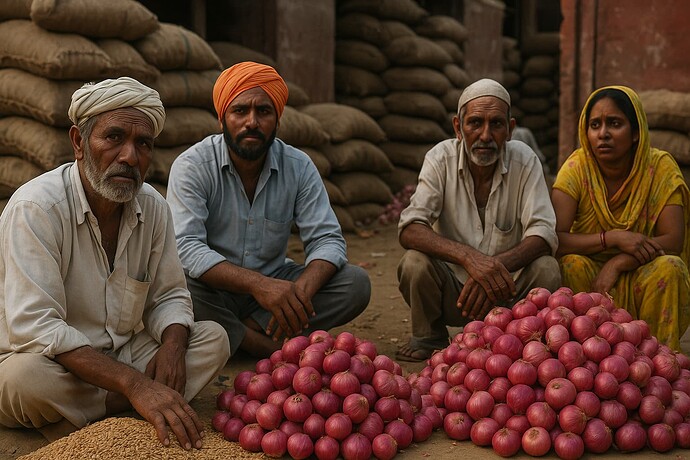Introduction Indian agriculture, which supports nearly half of India’s population, is facing a critical profitability crisis. Despite record production and higher Minimum Support Prices (MSP), rising input costs and weak procurement systems are squeezing farmer incomes. Villages across Uttar Pradesh, Bihar, Madhya Pradesh, Maharashtra, Rajasthan, and Punjab are particularly impacted. This updated report, based on April 2025 data, analyzes the realities behind the escalating cultivation costs, MSP gaps, and farmer distress.
1. Rising Input Costs and Their Breakdown
- Fertilizers: Prices for Di-Ammonium Phosphate (DAP) and other fertilizers have spiked globally, though government subsidies kept DAP at ₹1,350 per bag and urea at ₹242 per bag. Non-urea fertilizers like MOP have seen significant increases, raising nutrient costs.
- Diesel: Diesel prices in rural areas (₹88–93 per litre) have pushed up irrigation and transport costs.
- Seeds: Hybrid seed prices, such as Bt Cotton, have increased by nearly 18% over four years.
- Pesticides & Chemicals: Costs surged due to import dependency and higher taxes.
- Labor Wages: Agricultural wages grew modestly (~5–6% annually), still adding to operational costs.
2. State-wise Realities of MSP Gap
- Bihar and Uttar Pradesh: Although the new wheat MSP is ₹2,425/quintal, many small farmers sell below this due to weak procurement and urgent cash needs.
- Madhya Pradesh and Rajasthan: Bonus payments over MSP have boosted farmer prices (~₹2,600+/quintal for wheat).
- Punjab and Haryana: Strong procurement ensures realization of MSP for cereals.
- Maharashtra: Onion and cotton prices crashed below cost; cotton saw mass procurement by the Cotton Corporation of India.
- Oilseeds and Pulses: Price support operations were expanded but market prices for soybeans, chana, and masoor often hovered near or below MSP without intervention.
3. Structural Challenges and Policy Failures
- Limited Procurement Beyond Cereals: MSP is enforced mainly for wheat and rice.
- Poor Storage Infrastructure: The new cooperative storage scheme is promising but still under implementation.
- Weak Farmer Producer Organizations (FPOs): 10,000 FPOs have been formed but need capacity-building.
- Fragmented Markets: e-NAM expansion continues, but market access remains limited for many farmers.
- Debt and Climate Risk: High debt burdens and weather variability exacerbate financial instability.
4. Effects on Farmer Livelihoods and Debt
- Stagnant real incomes and mounting indebtedness.
- Distress sales and distress migration to cities.
- Increased farmer suicides linked to debt and low price realization.
- Rise of supplemental activities (dairy, poultry) as coping mechanisms.
5. Clear Recommendations for Future Action
- Expand Procurement Coverage: Sustain and scale MSP operations for pulses, oilseeds, and perishables.
- Lower Input Costs: Accelerate PM-KUSUM for solar pumps; promote organic farming and biopesticides.
- Diversify Farm Incomes: Push allied activities and rural food processing units.
- Strengthen Market Access: Boost e-NAM trading volumes and direct farmer-buyer linkages.
- Enhance Credit and Insurance: Universal Kisan Credit Card coverage and improved PMFBY execution.
- Mental Health and Social Support: Rural distress helplines, farmer counselling, and SHG mobilization.
- Research and Extension: Invest in drought-tolerant, input-efficient crop varieties.
Conclusion Despite strong government interventions and policy reforms, the profitability of farming for millions of Indian farmers remains under pressure. Input cost inflation and procurement gaps dilute the benefits of higher MSPs. Bridging this gap requires comprehensive and sustained action: expanding procurement, reducing costs, strengthening rural infrastructure, ensuring credit and insurance access, and supporting farmers both economically and socially. Timely and ground-level execution of announced programs will determine whether India can truly achieve inclusive agricultural prosperity.
Prepared by: Famalth Research Desk (27 April 2025)
